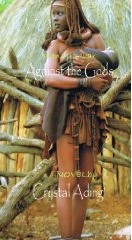 This book recounts the struggles of Wendy Bakari on her journey to womanhood. After a successful stay in the city to obtain her education, a jilted Wendy returns to a fictional African Village called Lufinga where she is forced to confront misogyny, evil spirits, female circumcision and other strange customs. Yet as the granddaughter of the village witch, she must walk a fine line lest she be consumed by her own desires.
This book recounts the struggles of Wendy Bakari on her journey to womanhood. After a successful stay in the city to obtain her education, a jilted Wendy returns to a fictional African Village called Lufinga where she is forced to confront misogyny, evil spirits, female circumcision and other strange customs. Yet as the granddaughter of the village witch, she must walk a fine line lest she be consumed by her own desires.
All posts by softie
The Flame Trees of Thika: Memories of an African Childhood
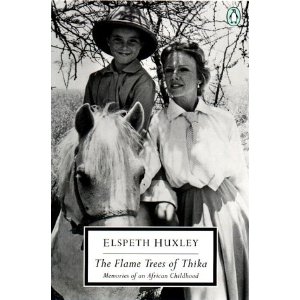 This book is a real literary treasure. I read
This book is a real literary treasure. I read
it first as a teenager. It astonished me then, with its unique portrayal of Africa. Who could fail to love the African wilderness and its diverse
people after reading The Flame Trees of Thika?! Africa seen through Huxley’s youthful eyes is given a magical quality I have never again encountered (though BBC came close to portraying it in their rendition of this book). And it continues to astonish me even now. The spectacular visual imagery from that book are a treasured keepsake, and the book itself is nothing less than a 20th Century masterpiece. It is a priceless gem and well worth the cost.
A literary autobiography set in Kenya during an uncertain
and enterprising colonial era before the First World War, this book is an ideal companion to those interested in the British Empire and African anthropology. For naturalists it
provides breathtaking accounts of white hunters and their quarry as a retrospective commentary on man’s abuse of Africa’s wild heritage. Huxley writes quietly, sensitively and impartially providing philosophic insights in a heuristic and magical narrative. Always compelling, this is an important primary text.
The Girl Who Played with Fire
 I found this viagra from canada book to be a solid sequel to The Girl with the Dragon Tattoo, in fact, I may have liked it ever better than the first.
I found this viagra from canada book to be a solid sequel to The Girl with the Dragon Tattoo, in fact, I may have liked it ever better than the first.
In this book we learn more about Salander. Skillfully exposed throughout the course
of the novel, bits and pieces of her background appear until by the end a full picture has emerged. Some satisfying, some not so satisfying. A couple points easily guessed early on.
She’s a fascinating character, and the parts about her were my favorite in the book, (even the parts that were seemingly plot irrelevant and never resolved). She’s a smart, strong, flawed underdog, and you can’t help rooting for her.
This book tackles a lot of topics. Sex trade, the media, police corruption, authority abuse, on and on. I like it because it keeps it interesting, but sometimes it was all over the board. Especially interesting to me is learning more about Swedish culture throughout the course of the book.
What’s best about the book is the pace. It kept me captivated throughout the 569 pages (in my copy), and I couldn’t go to bed until I finished. It’s a well-done thriller.
Incidentally, I didn’t find that you needed to have
read The Girl With
the Dragon Tattoo first, but certainly that would be preferable.
Looking forward to the 3rd, and sad that it will be the last. This is a really interesting series.
The Girl with the Dragon Tattoo
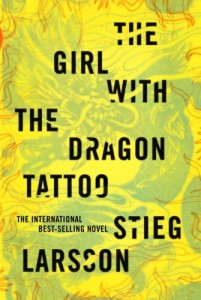 The Girl with the Dragon Tattoo is a masterwork of fine craftsmanship. When
The Girl with the Dragon Tattoo is a masterwork of fine craftsmanship. When
I reached the final page I was disappointed that there was no more to read. I did not want the story to end. The characters are too intriguing for this to be the end. Apparently this was the first novel in a trilogy by the brilliant writer, Stieg Larsson, who
unfortunately died in 2004: the book contains a tribute to him and his career. I cannot wait to read the sequels scheduled for release in the USA in 2009.
The Girl with the Dragon Tattoo is an international best seller and is set in Sweden. It takes a little effort to get accustomed to all the Swedish names and places but then the story moves with lightening speed. There are two key plots happening simultaneously. In one, a Swedish financial investigative journalist publishes a libelous attack about a powerful industrialist and is sentenced to jail, fined a ruinous sum, and has his career torn to shreds. Another industrialist, Vanger, hires the journalist to investigate the 36 year old disappearance of his then 14
year old grand niece. There has been no trace of her in all these years and she is assumed dead. Yet, every year on his birthday, he receives a mysterious gift of a pressed flower, mimicking a gift his missing grandniece used to give him when she lived there. Vanger, an old man, is tormented by the flower gifts, and wants one more chance to find out what happened to her and who killed her. What the journalist uncovers about the Vanger family’s hitherto unknown secrets and connections to the Nazis, will have you hanging on the edge of your seat.
The book is titled after yet another character, Lisabeth Salander, a societal outcast and social ward of the State, uncivilized without any desire to obey societal norms, and replete with piercings, tattoos, and a goth/biker appearance. In short, at first glance a totally undesirable and unsympathetic person. She is a researcher with a corporate security firm and ends up working with the journalist. In truth, she is a survivor of abuse in all forms with low self esteem, and an inability to trust. She is a genius with Asberger’s Syndrome, a form of autism, who sees patterns in things ordinary mortals miss and uses incredible computer hacking skills to accomplish her goals. She is fascinating: ruthless and tough to a fault, yet internally vulnerable, struggling to comprehend her own feelings. She has an appeal that draws you to her, rooting for her, and wanting to understand her. Lisabeth is unforgettable, unlike most characters that populate mystery thrillers. There is such depth here.
The book is a thriller on many levels: The story about the Vanger family itself, the journalist’s crusade to redeem his reputation, Lisabeth’s vendettas and development, and of course, the truth about what actually happened to the missing Vanger heiress. This is a superb novel and impossible to put down. Utterly stunning. Probably the best book in 2009.
Winston's War: Churchill, 1940-1945
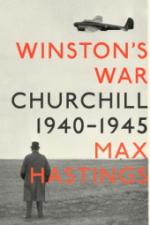 So many books have been written about Churchill, in particular about the wartime years, that another biography might be needless. However, Max Hastings presents a wonderfully balanced portrait of the man, the politician and the statesman. While in no way a revisionist history, Hastings has used distance and time to place Churchill’s immense contribution in historical perspective. It is fascinating to compare the Churchill revealed in the “War Diaries of Field Marshall Lord Alanbrooke” (from which Mr. Hastings quotes) with Hastings’ own work. Two brilliant accounts, one immediate with short term judgments and Mr.
So many books have been written about Churchill, in particular about the wartime years, that another biography might be needless. However, Max Hastings presents a wonderfully balanced portrait of the man, the politician and the statesman. While in no way a revisionist history, Hastings has used distance and time to place Churchill’s immense contribution in historical perspective. It is fascinating to compare the Churchill revealed in the “War Diaries of Field Marshall Lord Alanbrooke” (from which Mr. Hastings quotes) with Hastings’ own work. Two brilliant accounts, one immediate with short term judgments and Mr.
Hastings’s more measured and from a distance.
Churchill’s rhetoric and prose shaped the common view of the conduct of WWII. Brave little Britain fighting alone. “The Few, we will fight them on the beaches and never surrender.” How Churchill’s phrases captured and continue to color the imagination. Much less widely recognized are Britain’s problems during wartime. In a sense disguised by Churchill’s masterful language the strikes, the attitudes and the actions of the many Communist sympathizers and the often poor performance of Britain’s own Army (especially in the war’s early years) have tended to fade from popular viewpoint. Mr. Hastings deals with the good, the bad and the downright ugly without flinching and without using criticism to deflect from what was an overall immense achievement.
Whatever Churchill’s failings(and he was human), Max Hastings points out without Winston Churchill at the head of government, Britain would have probably capitulated in 1940-41. Churchill did not simply capture the British spirit, he to some extend, created it as this book makes clear. Had Churchill not done so, the outcome could have been entirely different or, at least, more protracted and bloody
without Britain as a base to launch the killer blow upon Nazi Germany.
Initially, having read many Churchill biographies I was afraid this might be a revisionist history that so
many authors are prone to write simply to sell their work. Max Hastings’ book about this great man who occupied this pivotal moment is well balanced and researched.
I highly recommend this book to anyone who is interested in this period of history. I have read many books by Max Hastings and this is one of his best. I also recommend the “War Diaries of Field Marshall Lord Alanbrooke” to gain even further perspective on the effect an individual can have on history.
Enjoy the read!
The Case of the Man Who Died Laughing
Tarquin Hall’s new “cozy”, is a great read for those interested in India, its people, and its customs. “Died Laughing” is Hall’s second mystery, and again features Vish Puri, a 50-something detective in Delhi who bills himself
as India’s “Most Private Investigator”. He’s often called on by public officials to look into crimes, as well as investigating for private clients. Puri also has a large family; wife, children, mother, and siblings as well as
a large cast of “operatives”, who often figure into Puri’s cases. In both books, so far, Puri’s mother, “Mummy” and his wife, “Rumpi” team up to solve a more home-grown crime among their friends. Vish, who wishes his wife and mother would just stop trying to do what he does, thankfully never learns about their crime-busting.
“Died Laughing” is a somewhat complicated story that involves magic, murder,
and fake Swamis. Operatives “Face Cream”, “Handbrake”, and “Tubelight” join Vish as he follows it all to a curious end.
Hall writes in detail about Indian society. Reading his books is almost a learning experience. His plots are almost incidental to character development. I’m looking forward to number three in his Vish Puri series.
So Cold the River
 This book begins with The protagoni
This book begins with The protagoni
st Eric Shaw at a funeral watching with the family the DVD video that he created of the deceased’s life.
He was trained as a film maker but has had issues with the people he worked with. When he has to take inderal and Xanax to get though the funeral you can figure that anxiety is one of his issues. After the funeral the sister of the deceased asks him to go to her father in law’s home town, French Lick, Indiana and find out something about his past. Her father-in-law has become very rich and is 95 years old but she knows nothing about his past and wants the video as a gift for her husband. She books him in at The West Baden Springs Hotel (This is a real place, a fantastic historical hotel), Google it! She gives him an unopened bottle of mineral water that her father in law, Campbell Bradford has had since
1929. The only thing he has from his past.
When he gets to the hotel, he can’t stop himself from drinking some of the water called Pluto water. He starts to have visions and headaches that is only relieved by drinking more of the water.
We are now in Stephen King territory, a nice place to be. He finds that there is only one Bradford left there and he is a terrible person.The book is very long but makes a very enjoyable read. It made me want to go and check out the area. I think they still have Pluto water there and the whole area is beautiful.
I really liked the book, the characters are interesting and the story is a mystery with lots and lots of strange things going on. I am going to be reading more of Michael Koryta’s books but think they can’t be as good as this one.I highly recommend it for anyone who likes something a little different.
Blind Descent: The Quest to Discover the Deepest Place on Earth
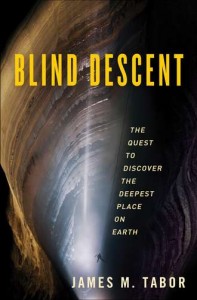 Caves and caving fascinate me, so when I saw there was
Caves and caving fascinate me, so when I saw there was
a book about supercave exploration, I had to read it. I am
so glad I did. I was absolutely glued to this book from the first page to the last. The only thing it lacked was a section of pictures, but that’s the price I pay for reading an advance copy–the published edition has several pages of them. Even so, I was able to look those up on the internet so I could have a visual reference,
which made the book even more powerful.
This is not so much the story of cave exploration as it is about cave explorers. Tabor researched two premier cavers from the USA and the Republic of Georgia, and devoted a section of the book to each. American Bill Stone has led several expeditions into supercaves in Mexico, while Ukranian Alexander Klimchouk has headed several European expeditions on the Arabika Massif in the Republic of Georgia.
In addition to following the amazing accomplishments of both men, Tabor explained in great detail the hardships and dangers involved in supercave exploration. I felt like I was there on the expeditions; rappelling, digging, crawling, diving, and freezing underground for days or weeks on end along with the cavers mentioned in this book. I have nothing but respect for this handful of people who risk their lives for the thrill of going thousands of feet underground and braving the dangers there in order to share their discoveries with the world. There’s pretty much no chance at all of me dropping down the first shaft of Cheve Cave, and forget it with Krubera, so I really appreciate this insider view.
I cannot recommend this book enough. It’s highly informative, giving outsiders an intimate view of what goes into supercave exploration, and it’s also an exciting page-turner. Tabor has a way of keeping readers on the edge of their seats as he takes us through real-life underground exploration. I found myself thinking of several fascinating topics I wish he would write about because he has a way of making an informative, nonfiction book into an exciting adventure, and not many authors can pull that off.
The Last Child
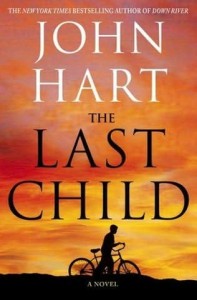 I dare you to read the prologue of this book without getting totally pulled in to the story. My heart was pounding by page 2, and I think my boss might want to have a talk with Mr. Hart because I went in to work a couple of mornings on very little sleep because I couldn’t put this book down until I got to the last word.
I dare you to read the prologue of this book without getting totally pulled in to the story. My heart was pounding by page 2, and I think my boss might want to have a talk with Mr. Hart because I went in to work a couple of mornings on very little sleep because I couldn’t put this book down until I got to the last word.
Johnny Merrimon was once a happy child. He and his twin sister, Alyssa, lived with their beautiful, vibrant mother and strong, caring father. Then Alyssa goes missing. She’s seen being pulled into a mysterious van, and a year later, Johnny’s life is completely different. His mother is bullied into passivity by a rich, abusive man who keeps her strung out on drugs and treats her like a possession. Johnny knows in his heart that he can find his sister, bring his father home, and save his mother, and for months he plays a dangerous game of spying on local child predators, convinced that at least one of them knows what happened to his sister. Detective Hunt is the haunted cop who cannot break out of his obsession with Alyssa’s case – and the beautiful mother – to save his own family from falling apart. Jack is the wounded best friend who idolizes Johnny and tries to mask his own pain with the alcohol he steals from his cop father.
Hart could have taken the easy way out and turned this into a suspenseful but heartwarming story of mystery
and redemption. Instead, he creates complex, rich characters and places them in terrifying, soul searching situations. Johnny is a child living with nightmares, and he reaches into ancient mysticism, searching
for strength and clues to help him heal his family. He’s seen too much of the harsh reality of life for someone his age, and this dark desperation colors all the events in this book.
I was, simply put, blown away by this book. It is well written, intelligent, and impossible to forget. A week after finishing it, I’m still thinking about it. Hart is now on my must-read list, and I look forward to reading his next novel.
Dead in the Family (Sookie Stackhouse, Book 10)
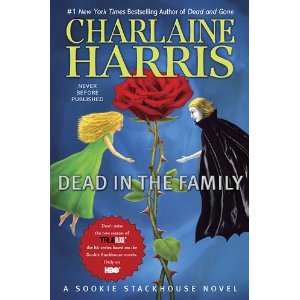 “Dead in the Family” has a very appropriate title — all sorts of family members pop up, and not just for Sookie. Charlaine Harris still can whips up a pleasant warm Southern vibe for her not-so-urban fantasies, but unfortunately this latest novel isn’t quite up to her usual standards: it’s basically a mass of fluffy in-between storylines that rarely go anywhere.
“Dead in the Family” has a very appropriate title — all sorts of family members pop up, and not just for Sookie. Charlaine Harris still can whips up a pleasant warm Southern vibe for her not-so-urban fantasies, but unfortunately this latest novel isn’t quite up to her usual standards: it’s basically a mass of fluffy in-between storylines that rarely go anywhere.
Just after Amelia leaves for New Orleans, Sookie’s cousin Claude appears at her home and asks to move in with her, since he’s a lone fairy who needs the presence of another. Bill is suffering from silver poisoning AND depression, and Sookie has to find a “relative” who can help him.
And Eric has some family issues as well — his maker Appius Livius Ocella shows up on Sookie’s doorstep, along with his “son”/lover Alexei.
To make matters worse, unidentified fairies and were have been crossing Sookie’s land,, and it also turns out that there’s a dead body buried back there. And it’s not Debbie Pelt’s. Now Sookie must unravel the secrets plaguing the supernaturals around her, or there might be even more deaths.
“Dead in the Family” feels like Charlaine Harris wrote half-a-dozen short stories, ripped them apart at the seams, and then sewed them back together. There’s no central plot to this book, just a mass of fluffy subplots woven loosely around each other. And some of the stories don’t really have much point to them, so the book feels cluttered and fragmented.
The saving grace is that some of those subplots ARE interesting, mainly the ones that develop the characters — the whole subplot involving Bill and the elderly Caroline Bellefleur is quite sweet and touching, and it should be interesting to see where Harris takes the religious/political pressure on the weres. And the typically bloody climax is a pretty shocking, gruesome one, if a bit slapdash.
But Sookie’s characterization is very shaky in this book — Harris zooms through her
entire recovery from being TORTURED in ONE CHAPTER (ARG! Cop-out!), and initially she seems so aggressive that it feels like she’s channeling Anita Blake. Fortunately she gets steadier and sunnier after
the first few
chapters, and it’s intriguing to see her various family members interacting with her — fae, were and telepathic human.
And there’s some much-needed development given to the sexy, devil-may-care Claude (it’s very cute when he’s goofing around on the playground with Hunter), as well as new insights into Bill and Eric’s lives and families (both living and undead).
“Dead in the Family” is all about the family ties, but it feels like Charlaine Harris just whipped together a bunch of short story ideas rather than writing a cohesive plot. Better luck next time.